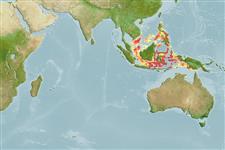>
Atheriniformes (Silversides) >
Phallostethidae (Priapiumfishes)
Etymology: Neostethus: Greek,neos = new + Greek, stetho, stethion = brest; literal = to prick a little breast (Ref. 45335).
Eponymy: Dr Deogracias V Villadolid (1896–1976) was Director of the Bureau of Fisheries in the Philippines, including during the Japanese occupation. (Ref. 128868), visit book page.
More on author: Herre.
Environment: milieu / climate zone / depth range / distribution range
Écologie
marin; eau douce; saumâtre benthopélagique. Tropical
Asia: Mindanao, Cuyo, Mactan, Negros Oriental and Leyte, Philippines.
Taille / Poids / Âge
Maturity: Lm ? range ? - ? cm
Max length : 2.3 cm SL mâle / non sexé; (Ref. 12768)
Occur in mangrove and nipa swamps (Ref. 280). Fertilization is internal and eggs are attached to the substrate via adhesive filaments (Ref. 43413).
Life cycle and mating behavior
Maturité | Reproduction | Frai | Œufs | Fécondité | Larves
Pelvic fins in males are modified to form part of a complex thoracic clasping organ (Ref. 205).
Parenti, L.R., 1989. A phylogenetic revision of the phallostethid fishes (Atherinomorpha, Phallostethidae). Proc. Calif. Acad. Sci. 46(11):243-277. (Ref. 12768)
Statut dans la liste rouge de l'IUCN (Ref. 130435: Version 2024-1)
Menace pour l'homme
Harmless
Utilisations par l'homme
Outils
Articles particuliers
Télécharger en XML
Sources Internet
Estimates based on models
Preferred temperature (Ref.
123201): 28 - 29.1, mean 28.6 °C (based on 66 cells).
Phylogenetic diversity index (Ref.
82804): PD
50 = 0.5002 [Uniqueness, from 0.5 = low to 2.0 = high].
Bayesian length-weight: a=0.00389 (0.00180 - 0.00842), b=3.12 (2.94 - 3.30), in cm total length, based on all LWR estimates for this body shape (Ref.
93245).
Niveau trophique (Ref.
69278): 3.0 ±0.3 se; based on size and trophs of closest relatives
Fishing Vulnerability (Ref.
59153): Low vulnerability (10 of 100).
